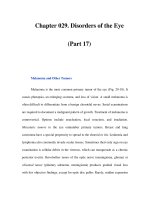Chapter 083. Cancer of the Skin (Part 7) doc
Bạn đang xem bản rút gọn của tài liệu. Xem và tải ngay bản đầy đủ của tài liệu tại đây (64.42 KB, 5 trang )
Chapter 083. Cancer of the Skin
(Part 7)
Treatment of Metastatic Disease
Melanoma can metastasize to any internal organ, the brain being a
particularly common site. Metastatic melanoma is generally incurable, with
survival in patients with visceral metastases generally <1 year. Thus, the goal of
treatment is usually palliation. Patients with soft tissue and nodal metastases fare
better than those with liver and brain metastases. Metastases limited to regional
nodes (AJCC stage III disease) warrant a therapeutic lymph node dissection.
Surgical excision of a single metastasis to the lung or to a surgically accessible
brain site can prolong survival. Stereotactic radiosurgery has been successful in
the treatment of isolated brain metastases. Radiation therapy can provide local
palliation for recurrent tumors or metastases. Patients who have advanced regional
disease limited to a limb may benefit from hyperthermic limb perfusion with
melphalan. High complete response rates have been reported, and responses are
associated with significant palliation of symptoms.
A number of drugs and biological therapies have demonstrated minimal
antitumor activity (15–20% partial response rates) in metastatic melanoma,
including dacarbazine (DTIC); the nitrosoureas carmustine (BCNU), lomustine
(CCNU), and semustine (methyl-CCNU); platinum analogues such as cisplatin
and carboplatin; vinca alkaloids such as vincristine, vinblastine, and vindesine; the
taxanes paclitaxel and docetaxel; IFN-α; and interleukin 2 (IL-2). Although
limited in efficacy, single-agent dacarbazine is still considered the standard
treatment. Ongoing trials are attempting to define superior combinations. IL-2
produces response rates similar to those seen with cytotoxic agents; however,
active doses usually cause greater toxicity than chemotherapy. Response rates of
>50% have been observed with IL-2 for intracutaneous and subcutaneous disease.
Melanoma can express cell-surface antigens that may be recognized by host
immune cells. These melanoma-associated antigens alone or in combination may
make it possible to develop vaccination strategies against melanoma. Such
strategies include the use of purified tumor proteins as immunogens and the use of
genetically altered tumor cells to elicit a T cell response. Alternative experimental
approaches include efforts to expand tumor-specific T cells (either obtained from
the tumor as tumor-infiltrating lymphocytes or harvested from the peripheral blood
after vaccination) in vitro and transfer them into patients in large numbers. In
addition, monoclonal antibodies to tumor antigens are being evaluated. Agents
directed against the cell cycle pathways are also currently in trial. All of these
experimental approaches will need considerable further development before being
applicable on a wide scale. Advances in treating metastatic disease may also prove
applicable in the adjuvant setting.
The absence of curative therapy for patients with metastatic melanoma
underscores the importance of early detection and prevention as strategies to
decrease melanoma mortality. Patients with stage 4 melanoma are best treated by
medical oncologists with expertise in treating patients with advanced disease.
Clinical trials should be considered as an option for this patient group.
Nonmelanoma Skin Cancer
Nonmelanoma skin cancer (NMSC) is the most common cancer in the
United States, with an estimated annual incidence of >1.5 million cases. Basal cell
carcinomas (BCCs) account for 70–80% of NMSCs. Squamous cell carcinomas
(SCCs), while representing only ~20% of NMSC, are more significant because of
their ability to metastasize (Fig. 83-2); they account for most of the 2400 deaths
annually. Incidence rates have risen dramatically over the past decade.
Figure 83-2
Cutaneous neoplasms. A. Non-
Hodgkin's lymphoma involves the skin
with typical violaceous, "plum-colored" nodules. B.
Squamous cell carcinoma is
seen here as a hyperkeratotic crusted and somewhat eroded plaque on the lower
lip. Sun-exposed
skin such as the head, neck, hands, and arms are other typical
sites of involvement. C.
Actinic keratoses consists of hyperkeratotic erythematous
papules and patches on sun-exposed skin. They arise in middle-
aged to older
adults and have some potential for malignant transformation. D.
Metastatic
carcinoma to the skin is characterized by inflammatory, often ulcerated dermal
nodules. E.
Mycosis fungoides is a cutaneous T cell lymphoma, and plaque stage
lesions are seen in this patient. F. Keratoacanthoma is a low-
grade squamous cell
carcinoma that presents as an exophytic nodule with central keratinous debris. G.
This basal cell carcinoma shows central ulceration and a pearly, rolled,
telangiectatic tumor border.









